
Linyphiidae, spiders commonly known as sheet weavers, or money spiders is a family of very small spiders comprising 4706 described species in 620 genera worldwide. This makes Linyphiidae the second largest family of spiders after the Salticidae. The family is poorly understood due to their small body size and wide distribution; new genera and species are still being discovered throughout the world. The newest such genus is Himalafurca from Nepal, formally described in April 2021 by Tanasevitch. Since it is so difficult to identify such tiny spiders, there are regular changes in taxonomy as species are combined or divided.
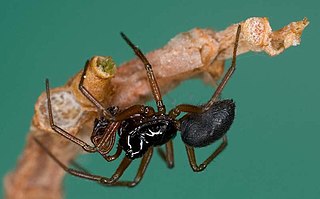
Erigoninae are the largest subfamily of sheet weavers (Linyphiidae), which is itself the second largest spider family. In the United States they are known as dwarf spiders, while they are called money spiders in England. The exact taxonomic limits of the subfamily are not yet known.

Norman Ira Platnick was an American biological systematist and arachnologist. At the time of his death, he was a professor emeritus of the Richard Gilder Graduate School and Peter J. Solomon Family Curator Emeritus of the invertebrate zoology department of the American Museum of Natural History. A 1973 Ph.D. recipient at Harvard University, Platnick described over 1,800 species of spiders from around the world, making him the second most prolific spider taxonomist in history, behind only Eugène Simon. Until 2014 he was also the maintainer of the World Spider Catalog, a website formerly hosted by the AMNH which tracks the arachnology literature, and attempts to maintain a comprehensive list, sorted taxonomically, of every species of spider which has been formally described. In 2007 he received the International Society of Arachnology's Bonnet award, named for Pierre Bonnet, in recognition of his work on the catalog.
The Halidae were a tiny spider family with only three described species in two genera. As of 2006, this family was no longer considered valid; the two genera are instead grouped in the family Pisauridae.

Spelungula is a monotypic genus of South Pacific large-clawed spiders containing the single species, Spelungula cavernicola, or the Nelson cave spider.

Paradictyna rufoflava is a spider of the genus Paradictyna endemic to New Zealand. It is a cribellate spider of the family Dictynidae.

Erigone is a genus of dwarf spiders that was first described by Jean Victoire Audouin in 1826. They are carnivorous, preying on small insects such as Psylla and flies. One of the distinctive characters for this genus is the presence of teeth bordering the carapace.
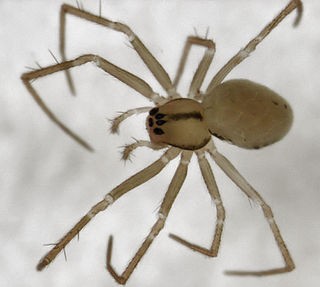
Diploplecta australis is a spider in the family Linyphiidae. It is found in the Antipodes Islands.
Microctenonyx is a genus of dwarf spiders that was first described by Friedrich Dahl in 1886.
Erigone autumnalis is a species of dwarf spiders in the family Linyphiidae. It is found in North and Central America, and it has been introduced to Azores, Europe, United Arab Emirates, and New Caledonia.
Erigone blaesa is a species of dwarf spider in the family Linyphiidae. It is found in the USA and Canada.

Erigone atra is a species of dwarf spider or money spider, in the family Linyphiidae. It is commonly found in North America, Europe, parts of Russia, Central Asia, China, Mongolia, Korea, and Japan. This spider is one of the most common Erigone spiders. E. atra is an important spider for agriculture, as it preys on pests such as aphids which are commonly found on crops. E. atra spiders are aeronautical spiders, as they travel via ballooning. This technique, sometimes referred to as kiting, allows E. atra spiders to traverse large distances and find new habitats when environmental or human stresses create unfit living environments. E. atra is difficult to differentiate from other congeneric species because of their similar sizes and coloring.
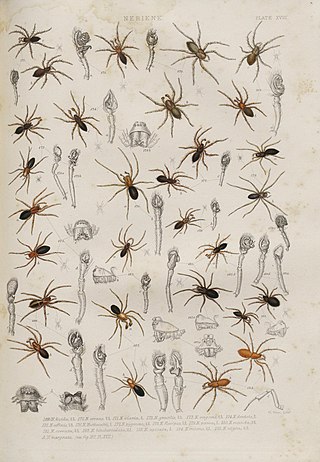
Dicymbium nigrum is a species of dwarf spider in the family Linyphiidae. It is found in Europe, Turkey, Caucasus, a range from Russia to Central Asia, and China.
Erigone dentosa is a species of dwarf spider in the family Linyphiidae. It is found in a range from the United States to Guatemala and has been introduced into Belgium.
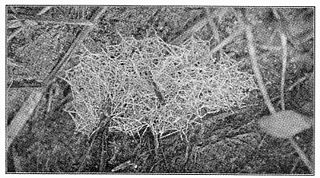
Erigone dentigera is a species of dwarf spider in the family Linyphiidae. It is found in North America, Europe, Caucasus, and Russia.
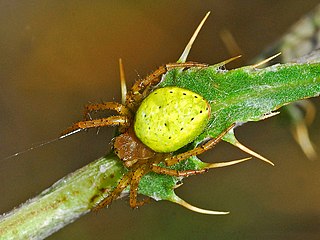
Araniella opisthographa is a species of orb weaver in the spider family Araneidae.
Erigone prominens is a species of sheet weaver spider.
Microctenonyx subitaneus is a species of sheet weaver spider.








